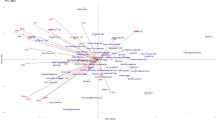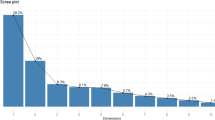Summary
A desirable genotype is a genotype performing well in a chosen set of environments. Three methods for identification of desirable genotypes were assessed in two cabbage data sets: regression analysis, multidimensional scaling of dissimilarity matrices, and biplot of deviation matrices. Using the regression approach is not recommended mainly for two reasons: (1) it is difficult to identify the desirable genotypes since one has to unify three parameters into one decision; (2) the regression method failed to identify the most desirable genotypes in one of the data sets. Multidimensional scaling and the biplot method were in accordance with each other and with the mean tables when different subsets where compared. Consequently, they were considered more adequate for identifying desirable genotypes. In cases where rank 2 approximation of the analysed matrix was justified, the biplot revealed more information in one display and was, therefore, considered particularly useful in plant breeding for larger target areas.
Similar content being viewed by others
References
Becker HC, Léon J (1988) Stability analysis in plant breeding. Plant Breed 101:1–23
Bucio Alanis L, Hill J (1966) Environmental and genotype-environmental components of variability: II. Heterozygotes. Heredity 21:399–405
Chatfield C, Collins AJ (1980) Introduction to multivariate analysis. Chapman and Hall, London
Crossa J (1988) A comparison of results obtained with two methods for assessing yield stability. Theor Appl Genet 75:460–467
Eberhart SA, Russel WA (1966) Stability parameters for comparing varieties. Crop Sci 6:36–40
Finlay KW, Wilkinson GN (1963) The analysis of adaptation in a plant-breeding programme. Aust J Agric Res 14:742–754
Gabriel KR (1971) The biplot graphic display of matrices with application to principal component analysis. Biometrika 58:453–467
Gordon AD (1981) Classification. Chapman and Hall, London
Gower JC (1966) Some distance properties of latent root and vector methods used in multivariate analysis. Biometrika 53:325–338
Haldane JBS (1947) The interaction of nature and nurture. Ann Eugenics 13:197–205
Hardwick RC, Wood JT (1972) Regression methods for studying genotype-environment interactions. Heredity 28:209–222
Jinks JL, Pooni HS (1988) The genetic basis of environmental sensitivity. In: Weir BS, Eisen EJ, Goodman MM, Namkoong G (eds) Proc 2nd Int Conf Quantit Genet Sinauer Associates Inc., Sunderland, pp 505–522
Kempton RA (1984) The use of biplots in interpreting variety by environment interactions. J Agric Sci 103:123–135
Mandel J (1971) A new analysis of variance model of nonadditive data. Technometrics 13:1–18
Mather K, Jinks JL (1982) Biometrical genetics. Chapman and Hall, London
Verma MM, Chahal GS, Murty BR (1978) Limitations of conventional regression analysis: a proposed modification. Theor Appl Genet 53:89–91
Westcott B (1986) Some methods of analysing genotpye-environment interaction. Heredity 56:243–253
Westcott B (1987) A method of assessing the yield stability of crop genotypes. J Agric Sci 108:267–274
Author information
Authors and Affiliations
Additional information
Communicated by P.M.A. Tigerstedt
Rights and permissions
About this article
Cite this article
Davik, J. Assessing three methods for identification of desirable genotypes in white cabbage (Brassica oleracea L. var. capitata). Theoret. Appl. Genetics 77, 777–785 (1989). https://doi.org/10.1007/BF00268326
Received:
Accepted:
Issue Date:
DOI: https://doi.org/10.1007/BF00268326




